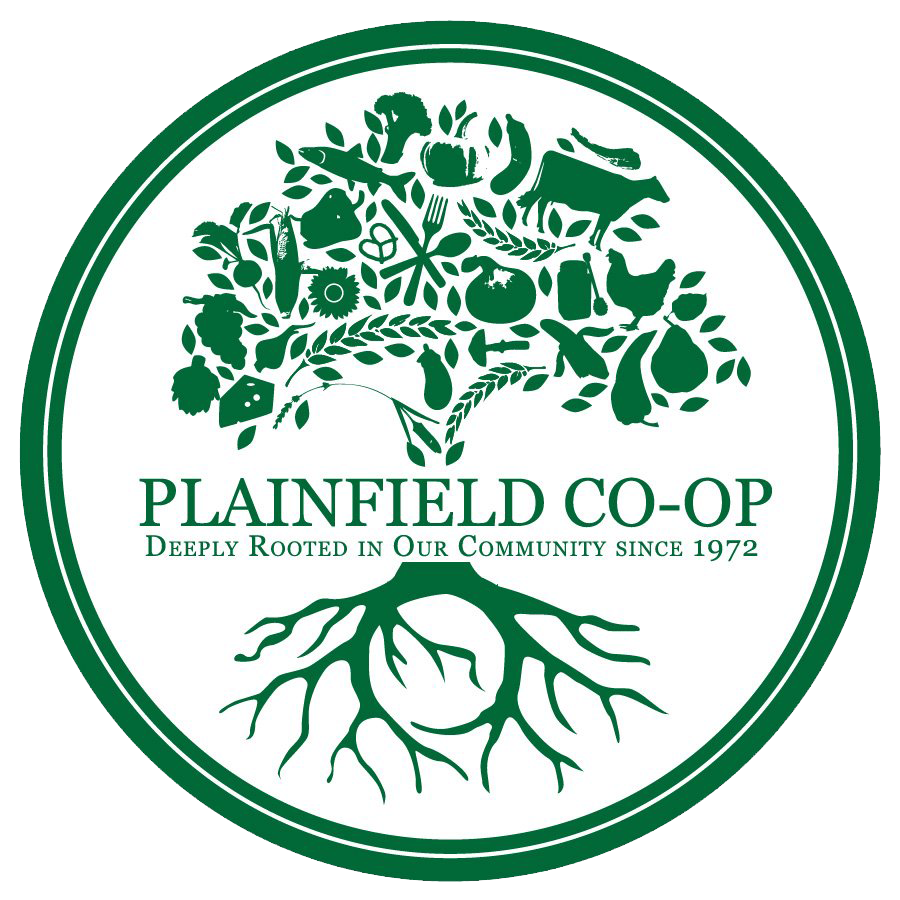The Plainfield Co-op’s early years
by Jim Higgins
Reprinted from Plainfield Co-op Newsletter: Fall 2010
The tempest created this summer by Hunger Mountain Co-op’s proposed expansion into Waterbury reminds me of a number of similarly-themed dust-ups during the Plainfield Co-op’s first five years, 1971-1975.
As I have written previously in this history column, the Co-op, during its first year or so, was viewed as something of a gangly toddler, mostly given a free pass over its foibles. But once the Co-op embedded itself into the Grange Hall late in 1972 we entered a lively adolescent period where vigorous debate amongst the most activist members was the norm. The debates emerged at the monthly meetings and later spilled out to ad hoc sessions for deeper discussion.
The three most contentious topics on Co-op agendas in those early years were:
- Product line: organic vs. non-organic;
- Political line: general political activism vs. exclusively food politics;
- Growth: centralized model vs. decentralized.
Organic vs. non-organic
To paraphrase Barry Goldwater, the 1964 Republican candidate for President, “Extremism in the defense of organic food is no vice,” or, at least, that’s what many of us projected to the world. The perception of natural foods elitism at the Co-op was, of course, an alienating force in the mainstream community. Our hard line friends were also quick to remind us that as long as we were mostly perceived as arrogant “food fascists,” we were doomed (in the 1970’s) to political irrelevance.
Despite the reality that most Co-op folks were a pretty down-to-earth group, as likely to enjoy an omelet made with caged eggs at the Wayside as one made with backyard eggs, tofu and sprouts, the unavoidable reality was that our monthly food ordering list was heavily skewed to the natural (slow) foods lifestyle. As my old buddy, Lee Webb, an activist (distinctly non-organic) teacher at Goddard College used to joke: “Hey Jim, I love the Co-op. but the only thing I can order from it is cheese.”
Our short-term fix to this dilemma was to dramatically increase the special projects. These were the famed 10%-above-cost truckload deals where anybody could participate in a community buy of items such as Stihl chain saws, canning jars, snowshoes, Florida oranges, maple syrup, and dozens of other “cross-over” items.
Later, once the walk-in retail operation kicked in, we were able to offer a few more “mainstream” items, especially cheeses, while maintaining our primary focus on the organic food movement and pipedreams of radical social change through the cooperative movement and organic takeover of the food system. It was the best we could manage to appease the anti-elitists. The Grand Union breathed a sigh of relief and we got slightly more serious about broadening the movement beyond the already converted.
General political activism vs. exclusively food politics
The first time we inserted anti-war flyers into the outgoing monthly food boxes, along with the newsletter and other food education items, we got slammed. Neighborhood coordinators were especially livid. These folks on the back roads labored hard to entice their mainstream neighbors to participate in the Co-op, then Whaap!, their neighbors got turned off by partisan politics with their food. The furor was such that we never again mixed our messages. Henceforth, all messages — if they were overtly political — were focused on the politics of food.
One non-food item on the monthly list — our first ever book — was a particularly effective medium for the Co-op’s view of things. “Diet for a Small Planet” by Frances Moore Lappè sold 1000 copies and was probably our most successful consciousness-raising venture.
Additionally the Co-op building itself was also a hotbed of news and workshops on the destructive practices of corporate agriculture, the prevalence and dangers of poisons in our food, plus visits from Helen and Scott Nearing and similar radicals, various community organizing ventures, and other interesting projects, such as a canning co-op spearheaded by Larry Gordon, which later blossomed into the Cherry Hill Cooperative Cannery.
Yes, many of our friends thought we could be doing more to advance various Movement causes, but the core Co-op organizers opted to do that on their own time.
Growth: centralized model vs. decentralized
The early Co-op seemed to grow exponentially. It didn’t, of course, but within three years we had about 300 separate orders coming in through the friendly, de-centralized neighborhood system, and the system was breaking down.
What to do? The obvious answer was to end the neighborhood ordering and distribution system and centralize operations at the Co-op building. Simultaneously, the massive Montpelier contingent was forming a breakaway republic, organizing a free-standing retail operation of its own. These were heady and contentious times, but one thing was for certain” the ‘good old days’ were over. Our numbers were simply too large to sustain a neighborly system.
Fast-forward to the present and we see the former breakaway republic of Montpelier, the now 5000-member Hunger Mountain Coop poised to spin-off a little Waterbury operation. Or not, depending on an upcoming membership vote.
Lo and behold, some of the same issues are being argued by members: Should we broaden our product line in Waterbury to include such items as Coke and chips to serve a greater cross-section of the populace? Are we going to weaken the arguably shaky Mother Ship by decentralizing operations to another town? Oh yeah, where’s the original political mission in all this? Didn’t we want to transform society into a cooperative-based, organic-only republic?
Sigh.
This is Jim Higgins’ seventh — and concluding — Plainfield Co-op history column for the newsletter. Higgins, a community organizer in 1971, was one of the founders of the Co-op, along with Liz Sokol, Marty Levin, Larry Gordon, Anne Temple, and Larry Lindgren.
